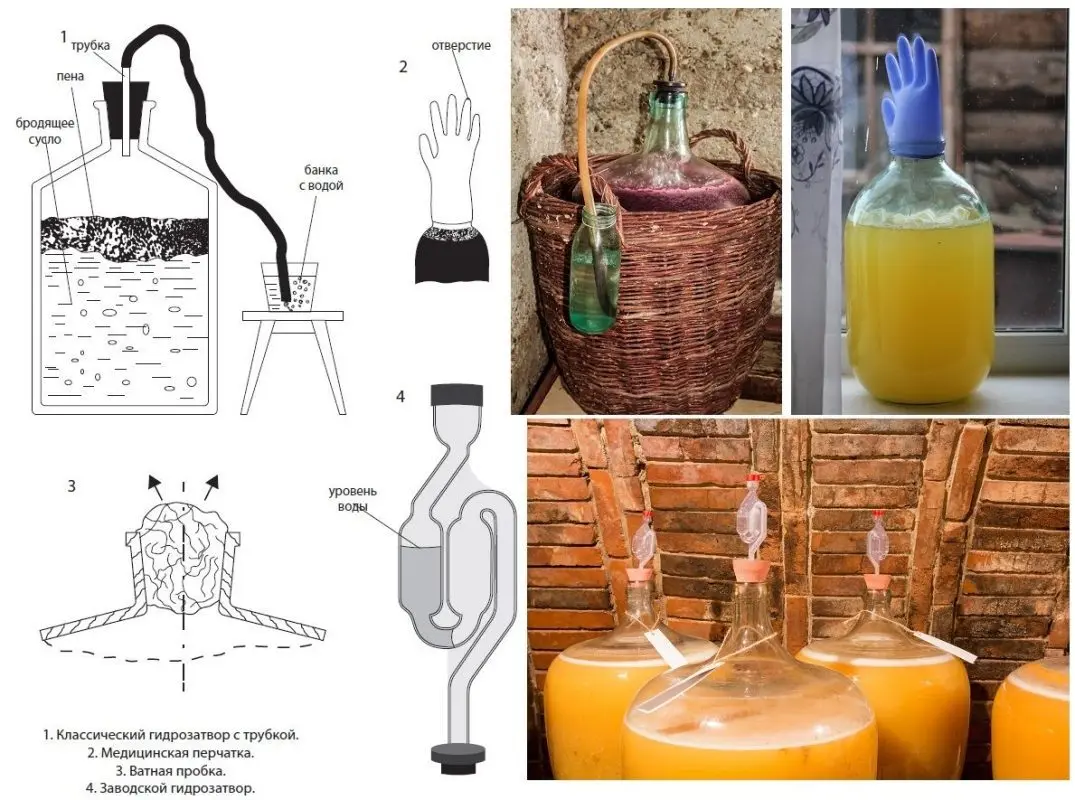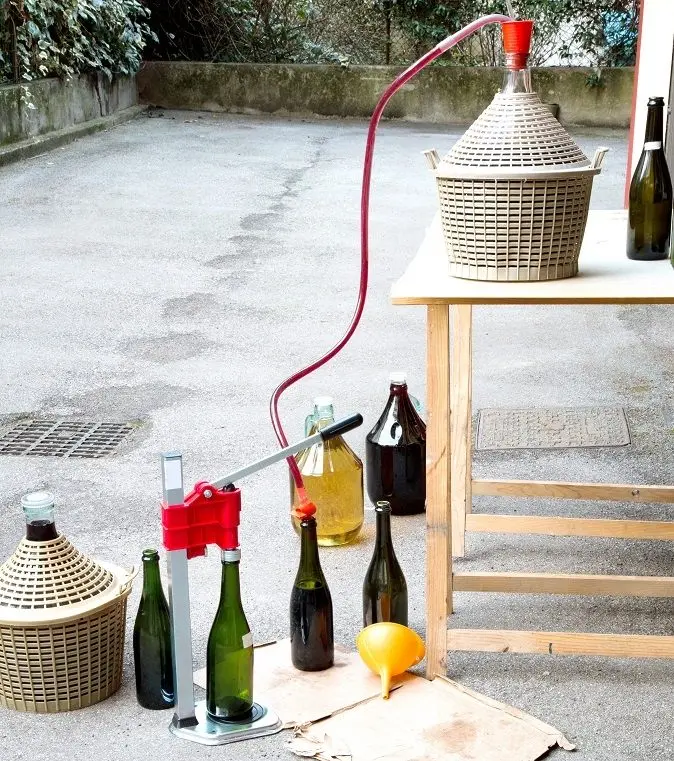Contents
Port wine is a type of fortified wine with a unique cooking technology. In the USSR, under this name, low-quality alcohol was produced, which had nothing to do with the Portuguese original, which spoiled the image of the drink. We will adhere to the classical technique adapted to home conditions. The recipe is simple, but calculations are required.
To obtain a home-made port with a predetermined strength and sugar content, you need to have devices for measuring the content of alcohol and sugar in the must – an alcoholometer and a wine meter (sugarmeter). If these devices are not available, you will have to act “by eye”, focusing on approximate values.
Theory
Most ports are made from red grapes, but whites are also acceptable. The amount of sugar depends on the initial sugar content of the berries (the higher the better) and the desired final sweetness of the finished drink. Water needs to be diluted only with very sour juice from grapes (strongly pinches the tongue) grown in the northern latitudes. It should be remembered that sugar and alcohol by themselves reduce acidity, and water significantly impairs the quality of the drink.
In the traditional technology of making port wine, unaged grape alcohol with a strength of 77% is added to the fermented must, then the blend is sent to barrels. At home, not everyone has the opportunity to organize aging in barrels or even on oak chips, so aging can be simulated by using high-quality cognac of at least 3 years of aging instead of grape distillate.
Usually the must is fermented with wild yeast, which is found on the skin of the berries. To play it safe, you can add wine yeast, sherry strains are ideal.
Ingredients:
- grapes – 10 kg;
- sugar – up to 250 grams per 1 liter of juice;
- water – up to 30 ml 1 liter of juice (in rare cases);
- grape spirit (cognac) – 1,2-6,5 liters.
- wine yeast – per 10 liters of must (optional).
port wine recipe
1. Sort the grapes, removing leaves, twigs, unripe, rotten and moldy fruits. Raw materials should preferably be collected in dry weather and not washed, so that wild yeast remains on the surface, which will start fermentation. Sterilize all used containers and tools with boiling water, then wipe dry with a clean cloth to avoid infection with mold and other pathogenic microorganisms.
2. Crush the grapes with your hands or in any other way, trying not to damage the bones, otherwise the must will be bitter.
3. Place the resulting grape mass in an enameled or plastic container with a wide neck – a pot or bucket. Leave a quarter of the volume free for foam. Add wine yeast if desired. Mix. If the grapes are very sour, add 100 grams of sugar and 30-50 ml of water per 1 kg of berries.
4. Cover the must with a cloth or gauze, transfer to a dark place with a temperature of +18-27 °C. Once every 8-12 hours, be sure to stir with a wooden stick or clean hands, drowning the pulp in the juice – poured skin and pulp. Without stirring, the wort can sour. After 12-24 hours, signs of fermentation should appear: foam on the surface, hiss, characteristic smell.
5. After 3 days, strain the juice through several layers of gauze and squeeze the pulp to dryness (no longer needed).
6. Determine the sugar content of the filtered juice. The optimal values are 18-19%. If necessary, add beet sugar to the juice, bringing the indicators to the recommended ones.
If there is nothing to measure sugar content, you will have to navigate by taste. The more acidic the juice, the more sugar is required. You can add up to 100 grams per 1 liter of juice, no more, otherwise fermentation may stop due to an excess of sugar.
7. Pour the juice into a fermentation tank, fill up to a maximum of 75% of the volume. Close the neck with a water seal or a medical glove with a hole in one of the fingers (pierce with a needle). Leave the container in a dark place (cover with a thick cloth) at a temperature of +20-27 °C.

The fermentation time depends on the desired characteristics of the port. In the classic version, the less fermentation of the must (the minimum period is only 2 days), the sweeter the port wine will be due to the unfermented sugars in the juice.
According to traditional technology, adding additional sugar is prohibited, but at home, the drink can be sweetened along with fixing and even after aging, adjusting the taste at your discretion, so this parameter is not very important.
Often, fermentation is stopped when the sugar content drops to 8-10%. If there is nothing to control this parameter, you can simply leave the wine to ferment for at least 12-15 days, the exact period depends on the fixing alcohol and is discussed in the next paragraph of the recipe.
Before fixing, decant (drain from the sediment) the fermenting wine into another container.

9. Calculate the required amount of grape distillate or cognac. To do this, measure the initial strength or sugar content of the wine, then determine the final strength of the port (18-23% vol.).
The vinometer immediately shows the alcohol content. In the case of a saccharometer, it is possible to determine the strength, knowing the initial and final sugar content of the wort, using the tables that come with the device. The second option is to take into account that 1% of fermented sugar gives approximately 0,6% strength. For example, if 12% of sugar has fermented, then the fortress will be 7,2% alcohol.
Calculate the required volume of fixing drink (V) using the forum:
V = volume of wine * (strength required – available strength) / (strong drink strength – required strength).
For example, if there are 6,5 liters of wine with a strength of 7,2% and forty degrees cognac as a fixative, and you need port wine with an alcohol content of 22%, then the required volume of cognac = 6,5 * (22 – 7,2) / (40 – 22) = 5,344 liters.
With the same parameters, if 77% wine alcohol is used: the volume of alcohol u6,5d 22 * (7,2 – 77) / (22 – 1,749) uXNUMXd XNUMX liters.
Conclusion: the higher the alcohol content in the fixing drink, the less it is required, which positively affects the taste and aroma of port wine, since the solids of the wine are in a smaller solution of the liquid – they are not diluted so much.
In the presence of cognac as a fortifying drink, it is advisable to leave the wine on fermentation until complete fermentation (12-14 degrees), and focus on the lower threshold of port wine strength (18-19 degrees). In the case of a strong wine distillate, the field for maneuver is much wider.
The calculation does not take into account the volume fraction of sugar and solids of wine, since at home it is not possible to determine these values more or less accurately. You just need to understand that sugar also reduces the fortress.
In rough calculations, the sugar content of port wine is simply adjusted in proportion to the change in the volume of the solution according to the following formula:
New sugar concentration = (volume of wine * sugar content * 0,01) / volume after curing.
For example, with a sugar content of 10%, there were 6,5 grams of sugar in 650 liters of wine, as a result of fixing with cognac, the volume became 11,844 liters (6,5 + 5,344), and the sugar content was 5,4%.
Again, additional sweetening to the standard 8-9% sugar will reduce the strength somewhat and increase the overall volume. You can make port wine 2-3 degrees stronger than planned, leaving a margin for adding sugar.
In the case of making port wine without a vinometer and saccharometer, the strength of the wine can only be determined very approximately: up to 20-25 days of fermentation – 5-9 degrees, after 25 days – 9-10 degrees. Fermentation of wine stops completely at an alcohol concentration of 12-14% vol.
10. Add distillate to wine according to calculations and sugar to taste for sweetness. Mix. Alcohol will stop fermentation, this is normal. Pour the finished mixture into an oak barrel and leave it in the cellar for at least 6 months; real port wine is aged for at least 2 years.
If cognac was used for fixing, then it is considered that the exposure has already been simulated and the drink can be bottled and hermetically sealed. Such a port wine will also be ready not earlier than in six months. When a precipitate appears with a layer of 2-4 cm, it is advisable to filter the drink by pouring it through a tube into another container.
Another option to imitate oak barrels when using unaged distillate (even well-cleaned sugar or fruit moonshine will do) is to add prepared oak chips to a glass container with a drink in the amount of 2-4 grams per 1 liter. The term of infusion depends on the concentration of tannins in the wood chips, the strength and the temperature in the room. It is necessary to try port wine every 10-15 days in order to remove the chips in time, otherwise there will be a too strong tannic aftertaste.










